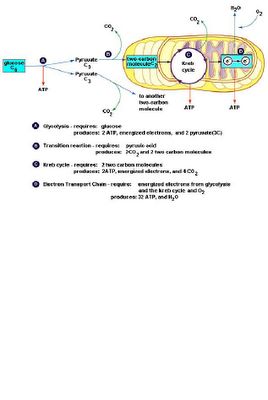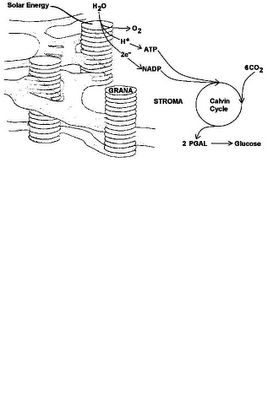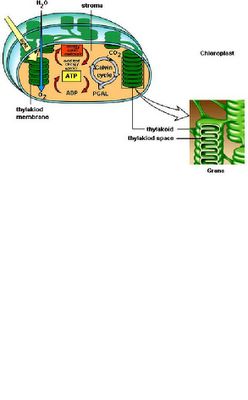
Cellular Respiration 
This is to help review cellular respiration. Please print this off and bring to class on friday to complete. I appologize for not being at school this week, but I have come down with pneumonia and a case of the flu.
Your UNIT TEST will be on WEDNESDAY MARCH 9th, as I want to go over a few things with the class first.
Glycolysis & Fermentation
1. What organisms trap sunlight & store it in carbohydrates?
2. What 2 organisms break down carbohydrates to release energy from cells?
3. What is the main energy currency of a cell?
4. Define cellular respiration.
5. What process begins cellular respiration & does it produce much ATP?
6. If there is no oxygen in cells, the products of glycolysis enter ________________________
pathways that yield no additional ______________________.
7. Fermentation is __________________________ because no oxygen is used.
8. If oxygen is present in cells, the glycolysis products enter the ______________________
respiration pathway.
9. Does aerobic respiration produce much ATP?
10. What simple sugar starts glycolysis?
11. In glycolysis, glucose is broken into 2 molecules of _______________________ acid
in the ______________________ of the cell.
12. In which part of the cell does fermentation occur? Is oxygen involved?
13. Name the 2 types of fermentation.
14. __________________________ acid fermentation helps make cheese & yogurt and also
occurs in _______________________ cells during heavy exercise.
15. What effect does lactic acid have on muscle cells?
16. Yeasts carry on what type of fermentation?
17. What alcohol is made in alcoholic fermentation?
21. Aerobic respiration requires what gas?
22. How much more ATP does aerobic respiration produce than glycolysis alone?
23. Name the 2 major stages of aerobic respiration.
24. What is completed in the Krebs cycle?
25. The energy carrier NAD+ is reduced to what substance?
26. Which part of aerobic respiration makes most of the ATP (cell’s energy)?
27. Where does aerobic respiration take place in prokaryotes?
28. Where do these reactions take place in eukaryotes?
SBI3U - Mr. SMITH BIOLOGY
Welcome to your interactive science experience. You will be able to view lesson materials, copy worksheets, and get review work from this interactive website. This website will have links posted for you to follow to gain a more in-depth understanding of the topics that we cover in class. Now, scroll thorugh, click on the links, send me emails and enjoy! (pg ref. from BIOLOGY 11 McGraw-Hill Ryerson textbook)
Wednesday, March 02, 2005
Tuesday, March 01, 2005
Monday, February 28, 2005
PROTEIN SYNTHESIS
PROTEIN SYNTHESIS
Read pages 56 to 58 in text. Complete pg 17 in HO. Please read tomorrows section on photosynthesis.
Protein synthesis involves a set of complex interactions between various organelles. This is important to the survival of the cell because proteins make a large number of different molecules from enzymes, hormones, structural and transport proteins.
Protein synthesis can be divided into two main processes
TRANSCRIPTION and TRANSLATION
TRANSCRIPTION takes place in the NUCLEUS
the information required to make a protein is carried on a segment of chromatin (DNA) called a GENE the BASE SEQUENCE on the gene will determine the type of protein made
The following is a sequence of events that takes place in order to transcribe a gene:
1.The site at which the gene is located on the DNA UNCOILS and EXPOSES the base sequence
2.Only ONE SIDE of the DNA is used as a TEMPLATE to copy the information into messenger RNA (mRNA)
3.Free floating ribonucleotides (RNA) in the nucleoplasm will pair up with their complementary base pairs on the coding DNA strand.
DNA ...............................................RNA
Thymine-Adenine............................ Adenine-Uricil(Replaces Thymine)
Cytosine-Guanine ............................Cytosine-Guanine
4.As the RNA nucleotides are joined together, the mRNA strand is RELEASED from the DNA and the DNA recoils into its double helix
5.Once the gene is completely transcribed it is released and moves into the CYTOPLASM through a nuclear pore
TRANSLATION
1. once the mRNA is in the cytoplasm, the ribosomes will attach to the mRNA
strand.
2. the ribosome covers six bases on mRNA
3. the code on mRNA is read three bases at a time
4. these three bases are called a CODON
5. each codon codes for one amino acid
6. transfer RNA (tRNA) is the molecule that carries the amino acid to the
ribosome and mRNA
7. tRNA has a triplet of bases (anticodon) that is complimentary to the mRNA
codon
8. each ribosome can hold two tRNA
9. once the two tRNA anticondon are paired correctly with the mRNA codon, the
ribosome will join the two amino acids together by forming a PEPTIDED BOND
10. the first tRNA is then released from the ribosome and will pick up another
amino acid
11. the ribosome will move down one codon and the second tRNA moves into the f
first position with the growing polypeptide chain
12. a new tRNA move in the open position with its amino acid and the steps are
repeated
13. once the ribosome reaches the end of the mRNA strand they are released from
each other
14. the polypeptide chain will then fold into its functional shape.




